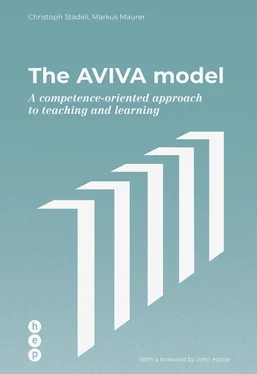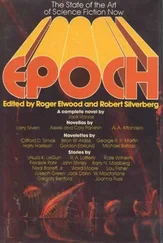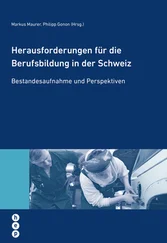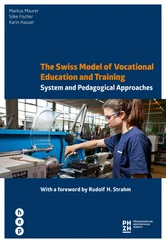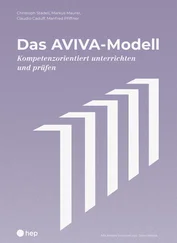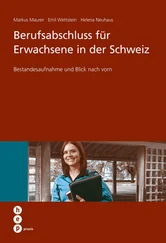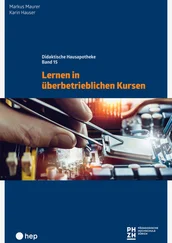For each phase, the teacher’s lesson preparation will involve choosing suitable methods by which learners can develop the content. We call the interplay of phases and methods the “choreography” of the lesson (Oser & Baeriswyl, 2001). Whilst the learning pathway (phases) is stipulated, the methods are more or less freely selectable (Städeli & Caduff, 2019), although not every method is equally suitable for each phase.
| PHASES |
DIRECT PROCEDURE |
INDIRECT PROCEDURE |
| A Arriving and engagingIn German “A” for “Ankommen” |
The learning goals and programme are made known. |
The situation and the problem are presented, while the learners determine goals and procedures largely by themselves. |
| V Activating prior knowledgeIn German “V” for “Vorwissen aktivieren” |
Learners activate their prior knowledge under the guidance and structure provided by the teacher. |
Learners activate their prior knowledge independently. |
| I InformingIn German “I” for “Informieren” |
Resources are developed or expanded jointly; the teacher shows the way. |
Learners determine for themselves which resources they still need to acquire and how to proceed. |
| V ProcessingIn German “V” for “Vertiefen” |
Learners actively handle the given resources: processing, deepening and consolidating them. |
Learners actively handle the newly acquired resources: processing, deepening, applying and consolidating them. |
| A EvaluatingIn German “A” for “Auswerten” |
Goals, procedures and learning outcomes are reviewed. |
Goals, procedures and learning outcomes are reviewed. |
Table 2 The AVIVA learning phases
1.2.5 AVIVA – Three advantages
The AVIVA model is not exactly new; however, it brings to the fore the essential elements of a well-structured lesson. For each phase of a lesson, AVIVA identifies exactly which resources teachers can aim to develop, and with which methods. The advantages for all involved are evident:
1.The AVIVA model is a means of analysis and at the same time an orientation grid. It shows us which resources can be meaningfully developed in which phase, with which methods. Thus, resources and competencies are not developed at random; both are directly connected to the contents (determined by each phase) and the way in which the contents are transmitted (determined by the chosen methods/ways of working).
2.AVIVA is at the same time a coordination instrument. A lesson which is planned and carried out using this model can also be observed and described from outside. Precise criteria make it possible for all those involved to analyse the lesson and try to optimise it. Particularly when implementing curricula/syllabi/training plans in VET programmes that involve both schools and companies, precision and systematicity are valuable for facilitating the coordination of education and training modules that take place across the different learning locations.
3.The AVIVA model, ultimately, supports self-directed learning. If the teacher explains the AVIVA model to the learners, they will be better at purposefully developing specific resources and increasingly take control of their own learning.
School learning can easily be structured around these five AVIVA phases, such that the learning process is completed (in terms of content and methodology) independently of whether a teacher chooses the direct or the indirect procedure. To systematically prepare and structure the lessons requires, as Hattie and Zierer (2018) put it, hard work and perseverance, and “one of the most important challenges for teachers consists in not just adopting this attitude to the learning process but also transmitting it to the learners. It is the basis for life-long learning, for an education that lasts for a lifetime.” They furthermore argue that the way to implement this behaviour is through a sensible didactically-oriented articulation of the lesson (p. 67), as is described in the AVIVA model.
2 The AVIVA model: phase by phase
Конец ознакомительного фрагмента.
Текст предоставлен ООО «ЛитРес».
Прочитайте эту книгу целиком, купив полную легальную версию на ЛитРес.
Безопасно оплатить книгу можно банковской картой Visa, MasterCard, Maestro, со счета мобильного телефона, с платежного терминала, в салоне МТС или Связной, через PayPal, WebMoney, Яндекс.Деньги, QIWI Кошелек, бонусными картами или другим удобным Вам способом.
